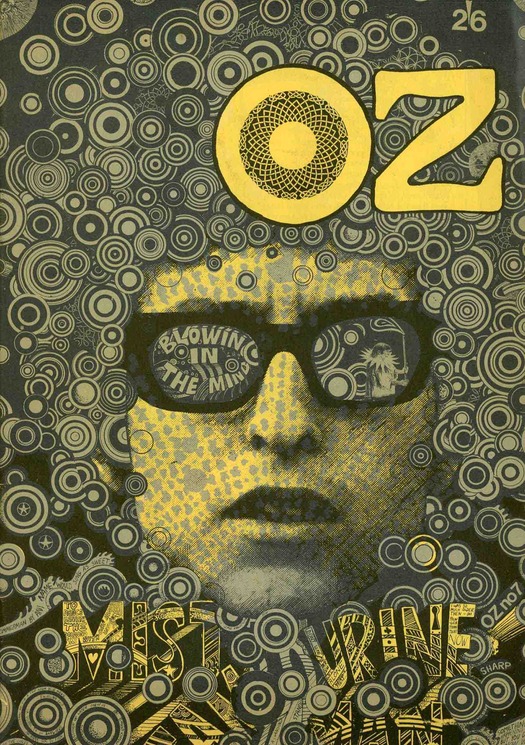
Martin Sharp, Oz no. 7 (London), October 1967
I was saddened to hear about the death of the Australian graphic artist Martin Sharp. In the 1960s, Sharp (born in 1942) was a brilliant innovator in illustration whose cartoons, collages and designs erased artificial distinctions between applied image-making and fine art. I first saw his work in the 1970s, as a teenage reader of the tail end of the underground press, and decades later it has lost none of its charge for me. To read Sharp’s obituaries and commentaries is to be reminded of the difficulties of accurate assessment that his work poses. British admirers of his artwork for Oz in London and his psychedelic posters and record sleeves have most likely never seen his work for the first Australian Oz and know little or nothing about Sharp’s activities after he returned to Sydney. Australian admirers won’t know much about Sharp’s work for London Oz unless they have access to old copies of the magazine. The handful of iconic images of covers and posters circulating on the Internet give only a partial sense of Sharp’s visual concerns in those years.
Sharp didn’t make it easy for would-be chroniclers. For years I wanted to interview him and, in September 2001, on my first trip to Australia, I finally had a chance. I had never seen an interview with Sharp in the UK design or art press about his early career and my hope was to produce a Q&A for Eye, presented in its “Reputations” series, with extensive illustrations. Even making contact with Sharp proved difficult and I was advised to go through an intermediary. But the arrangement was confirmed and I went to the rambling mansion he inherited from his grandmother in Bellevue Hill, an affluent Sydney suburb favored by art gallery owners, property developers and surgeons.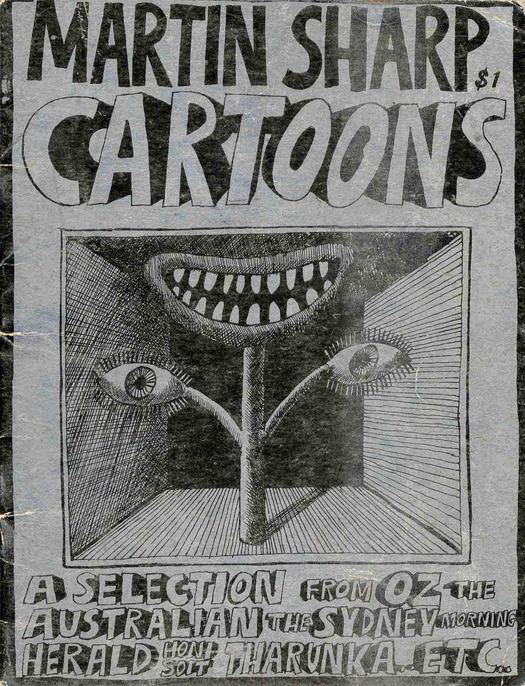
Martin Sharp, Cartoons, published by Scripts Pty., 1966
I had done some library research, read a few old Australian profiles and photocopied a wonderful 1966 catalogue of Sharp’s cartoons published in Oz, the Australian, the Sydney Morning Herald and elsewhere. It seemed that Sharp had been obsessed for many years with the singer Tiny Tim and with a fire that had taken place in 1979 at the Luna Park amusement park in Sydney, killing seven people. He loved Luna Park and it was a calamitous personal turning point for him. He believed the victims were murdered.
Sharp was welcoming and polite, if a little distant. He walked me around, showing me his ultra-bright, cartoonlike, thickly encrusted paintings, which he famously worked on obsessively for years. He talked with animation about Tiny Tim and Luna Park and his research into the fire. When it came to recalling the long-gone era of countercultural, psychedelic London, there was little he wanted to say and certainly not enough to sustain a Q&A. It was one of just two occasions I have known when a face-to-face interview produced nothing I could publish. I wondered whether there was some way of salvaging the situation, but back in London the distance was too great to make it happen. The story has a nice coda, though. On a visit to Melbourne in 2002, an academic named Keith Robertson gave me some issues of the Australian edition of Oz, a copy of the 1966 Cartoons selection, and Catalog, an extraordinary publication by Sharp from 1971. Having wondered when and how to use these gifts for 11 years, I’m pleased to show some pages here. 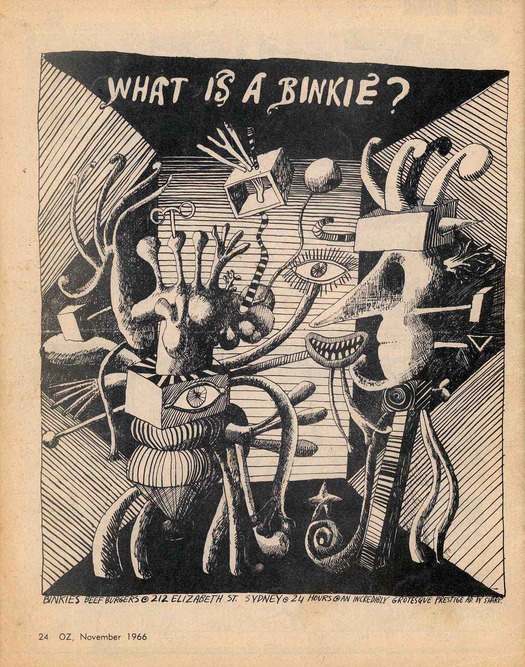
Martin Sharp, ad for Binkies Beef Burgers, back cover of Oz no. 31 (Sydney), November 1966
In Days in the Life, Jonathon Green’s magnificent oral history of the English underground, Sharp’s friend and fellow Oz founder Richard Neville draws a distinction between the phases of Sharp’s career. “Oz went psychedelic in issue no. 3. I think Martin had started taking acid. Prior to that he was a satirical social commentator.” There is some debate about the precise early issue of Oz in 1967 that represents its conversion to psychedelia, but where Sharp is concerned, Neville’s suggestion of two clear phases is too neat and only superficially fits the evidence found in Sharp’s work before London and while he was based in the city. Motifs seen in Sharp’s psychedelic work were already present in his Australian output before he took LSD — assuming that happened in London, as Neville suggests. The surreal, tubular, treelike form with two eye stalks and a sinister grinning mouth that occupies the cover of Sharp’s famous “Magic Theatre” issue of Oz (no. 16, 1968) can be seen on the 1966 Cartoons catalogue cover (above). I have a copy of the November 1966 issue of the Australian Oz, which has a bizarre advertisement by Sharp for Binkies Beef Burgers in Sydney (above) executed in the fantastical biomorphic manner of his Roundhouse UFO poster (1967), Wheels of Fire sleeve (1968), and Playpower book cover (1970) for Neville. (This ad might have been produced originally for an earlier issue, since Sharp was in London by that date.)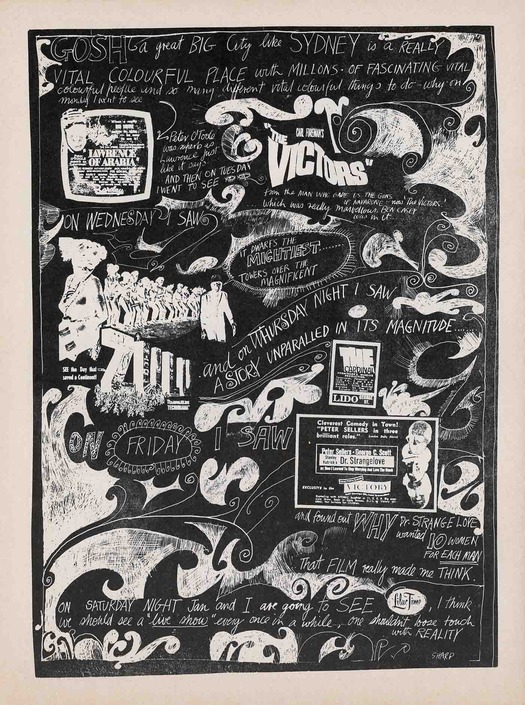
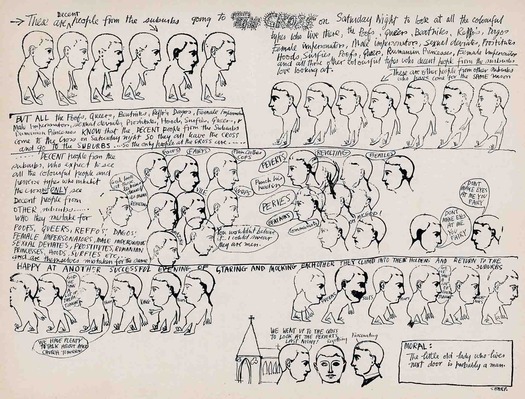
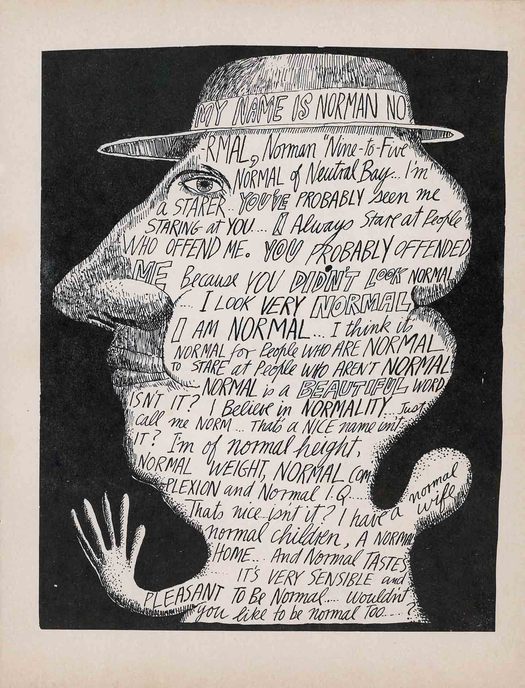
Martin Sharp, drawings from Cartoons, no original sources given, mid-1960s
The Cartoons catalogue does reveal early Sharp, as Neville says, to be a social commentator in possession of a mordant satirical wit. It’s a shame now that the book gives none of the sources or dates of publication. Sharp’s line quivers and races with nervous energy, yet there is a biting sense of control in even his sketchiest, most improvised looking drawings. Some of the cartoons have the minimal word counts typical of the genre, but in others Sharp integrates long handwritten monologues and verbal sketches, which become another kind of drawing by virtue of his great fluency as a penman. A case in point is the cartoon of Norman Normal (above) — “It’s very sensible and pleasant to be normal” — whose outline fills up with his sanctimonious musings on normality. Norman Normal returned in a post-psychedelic strip by Sharp in the fourth London Oz and shows up again as a gent in a bowler hat on the orange perforated sticker sheet that formed the cover Sharp designed for issue 7, a concept that was highly original in the magazine publishing landscape of its time (see cover below). (There is no relation to the Norman Normal Warner Bros. cartoon.)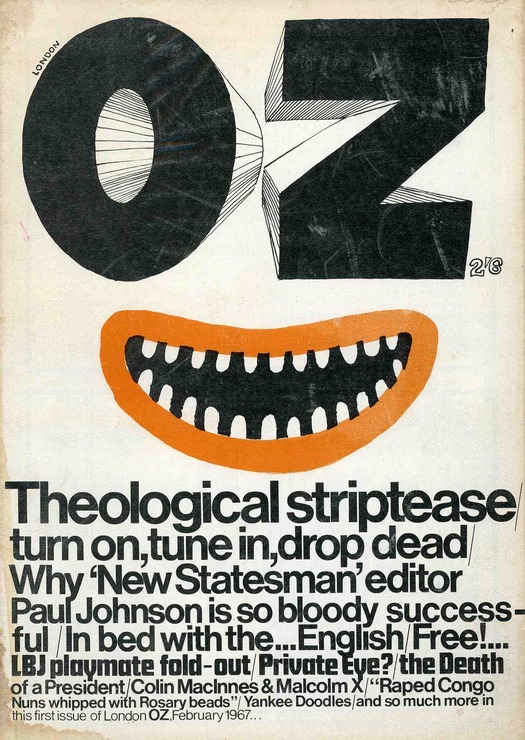
Titlepiece and illustration by Martin Sharp, Oz no. 1 (London), February 1967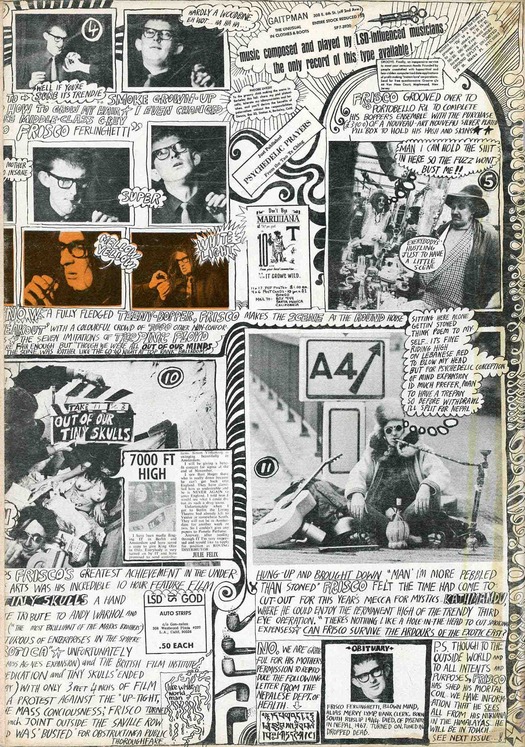
Martin Sharp, back cover of Oz no. 1
Sharp continued his editorial interweaving of word and image in the first issue of the new Oz in February 1967, which he announced with a leering toothy mouthpiece — in a photo in Neville’s 1995 memoir Hippie Hippie Shake, taken soon after they arrived in London, Sharp holds a similar cutout mouth on a wire in front of his own. At the back of the issue is a three-page fold-out section by Sharp devoted to a hippie-fied photo-strip with collage elements, inky embellishments and lengthy handwritten captions, titled “The Somewhat Incredible Turning on of Mervyn Lymp, Bank Clerk.” (See the back cover above.) The densely composed strip anticipates the even more violent collision of word and image that would follow, two years later, in Sharp’s “Magic Theatre” issue.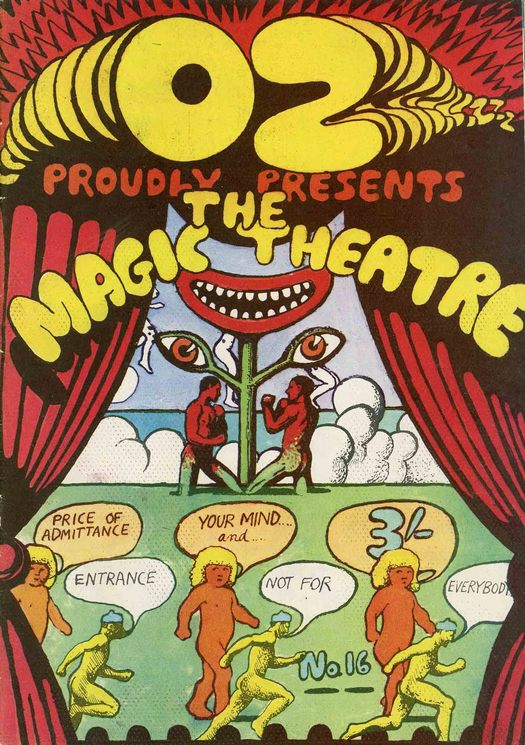
Martin Sharp, Oz no. 16 (London), “The Magic Theatre,” November 1968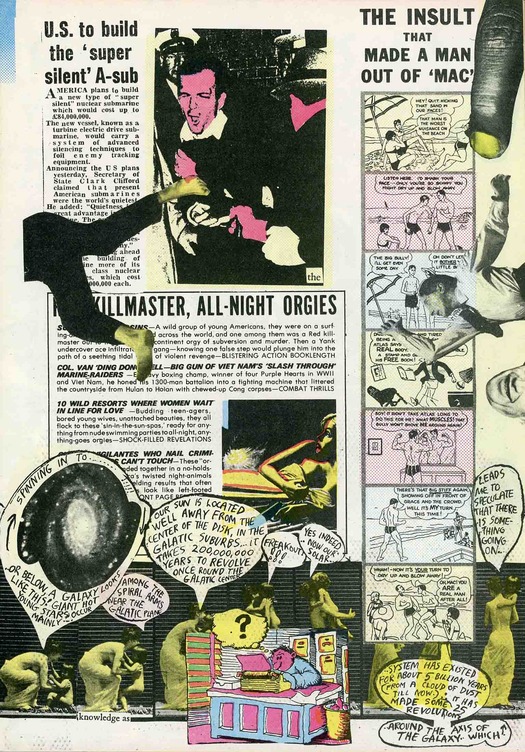
Martin Sharp, Oz no. 16, page from “The Magic Theatre” 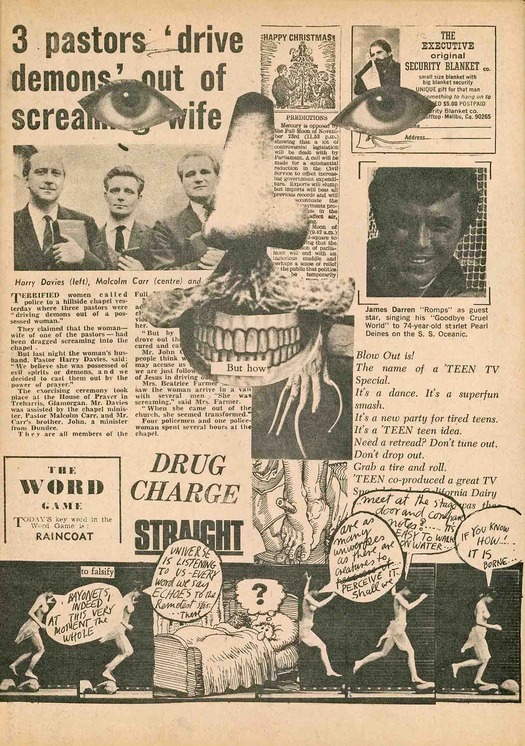
Martin Sharp, Oz no. 16, page from “The Magic Theatre”
Over the years, this prodigious 48-page volcanic lava flow of collage has received admiring mentions — I have written about it myself in Design Without Boundaries — though mainly from those who experienced its full impact on publication, since it’s now so hard to see. The radical writer David Widgery, who contributed to Oz, dubbed it, “the one thing created by the psychedelic era which might be looked at with interest in 100 years’ time.” The late Robert Hughes, art critic, was also impressed. Casting aside any conventional notion of magazine content and structure, dispensing even with the editors, Sharp and an assistant performed a demented Frankenstein suture-fusion of purloined images of news stories and headlines, small ads, comic books, Hollywood movies, bodybuilders, starving children, John and Yoko, Chang and Eng, Eadweard Muybridge, Winsor McCay, Max Ernst, René Magritte, and Robert Crumb. There is a speech-bubble running commentary from Sharp, quotations from Shakespeare — “It is a tale told by an idiot, full of sound and fury, signifying nothing” — and Tiny Tim is in there somewhere, too. The magazine remade as a theater of everything.
At root, this looks like it is still satirical social commentary, but it is commentary conducted with ambivalent new tools, a viscerally intense graphic/psychedelic anatomization that both manifests and critically explodes the self-indulgent pharmacological consciousness of the late 1960s. Sucked into the global maelstrom of politics, disaster and the media spectacle, Sharp arrives at tragicomic conclusions — “Price of admittance your mind” — that seem close to despair.
In another memoir of the era, In the Sixties, Barry Miles remembers Sharp coming into the Indica bookshop in London, where he worked as manager, and buying an expensive book of Van Gogh’s paintings. “To my horror he immediately began tearing out the pages,” Miles writes. “It was his book, of course, and I knew that he was intending to use them for his collages, but I hate to see books mistreated. He tore out the pages he wanted and tossed the mutilated book in the wastebin.” Whether this memory is embroidered or not, it supplies an indelible vision of the artist’s urge to cut up the object of desire, the world, into new configurations, and it is absolutely in tune with the obsessional qualities that Sharp showed in his 1960s art-making and for the rest of his life. He wasn’t in any sense disrespecting Van Gogh. His repeated quotations of the artist in projects such as the miniature paired-painter collages in Art Book (1972) were an act of allegiance and celebration. 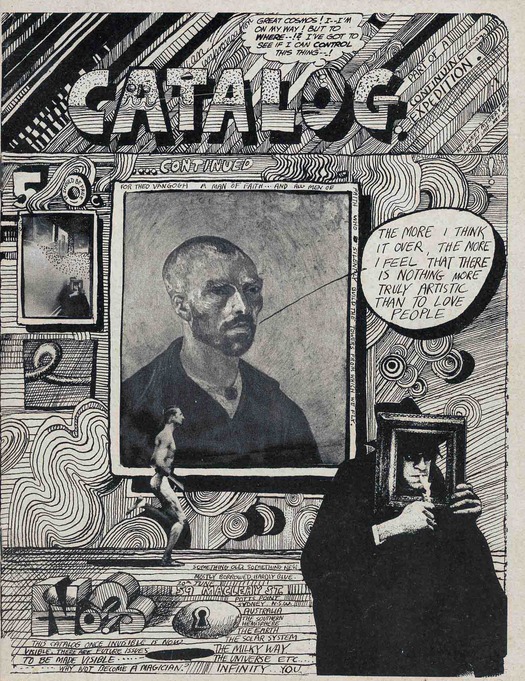
Martin Sharp, Catalog, published by Reid Books, 1971
Vincent appears as talisman on the cover of Catalog produced in 1971 for a show of Sharp’s work in Sydney. The 36-page exhibition guide, which Sharp likened to a digestive process, is a confessional scrapbook built organically, at the end of each day, from his handwritten meditations, passages cut from books and papers, reviews of his work, and snippings of cartoons and photos set against a churning backdrop of sinuous line work and rogue outgrowths of globular matter. “The images have been imprisoned inside me for too long: they want to get out,” says one cutting, and the whole piece feels like the outpourings of a graphomaniac racked by a fever of involuntary automatism. Sharp even quotes André Breton’s definition of Surrealism: “Thought’s dictation, free from any control by the reason, independent of any esthetic or moral preoccupation.” 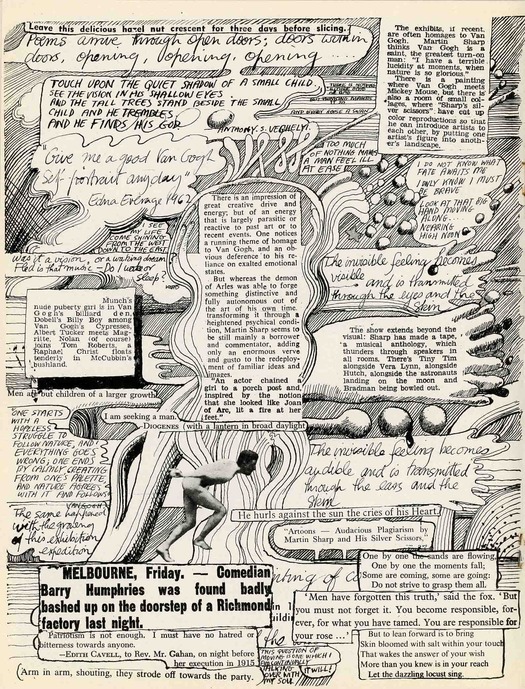
Martin Sharp, page from Catalog
Sharp seems never to have been interested in playing by the art world’s rules and his work in the 1960s falls between the spheres of art and design. A paper by Anthea Gunn published in 2010 in the Journal of Australian Studies, examining his “dual identity” as a graphic artist and visual artist and how he resolved it, is a sign that proper consideration of his early career might finally happen now. A scholarly monograph that connects every area of Sharp’s practice, brings his less familiar work to light, and explores the complexities of his innovative graphic art is long overdue.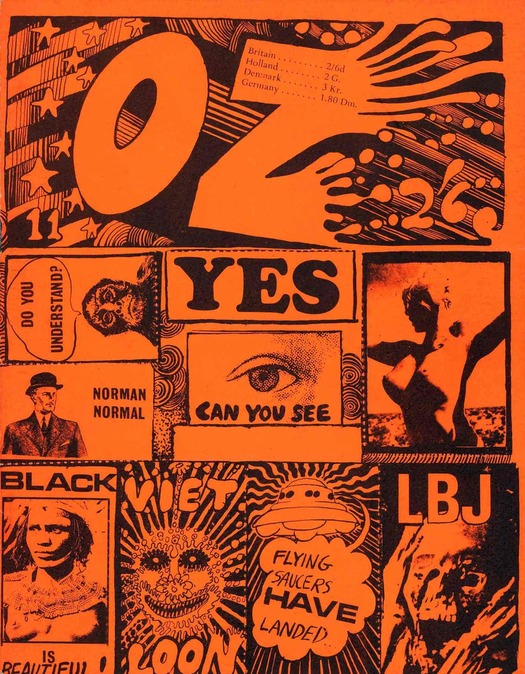
Martin Sharp, Oz no. 11 (London), cover formed of perforated stickers, April 1968
All images from the collection of Rick Poynor
See also:
On My Shelf: Richard Neville’s Playpower


Comments [2]
12.08.13
12:54
01.27.14
04:46